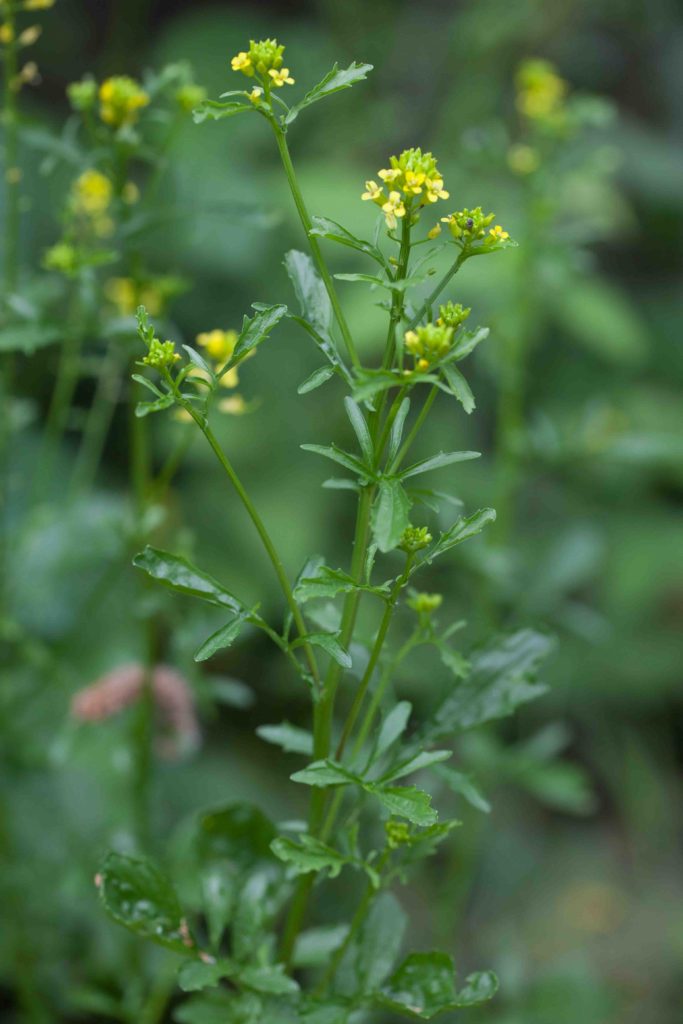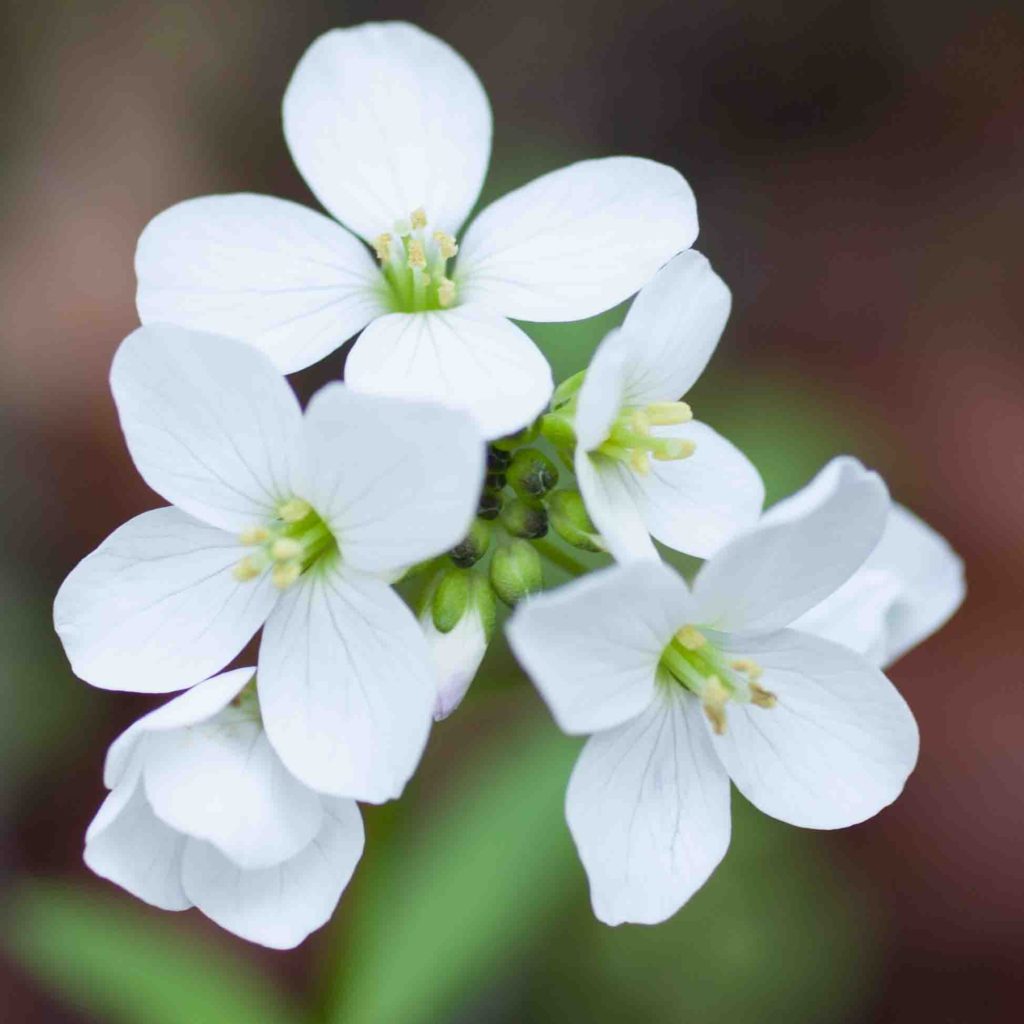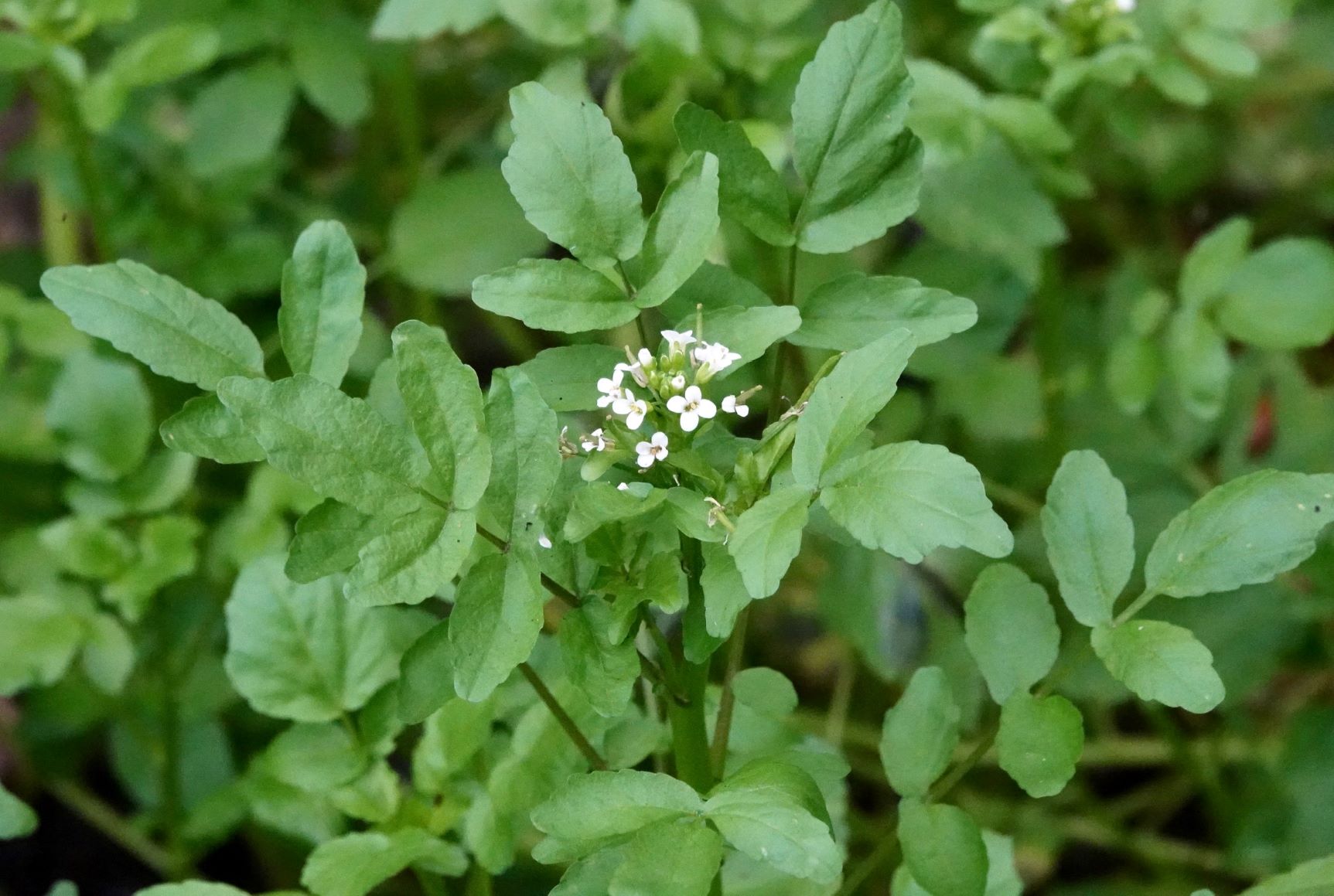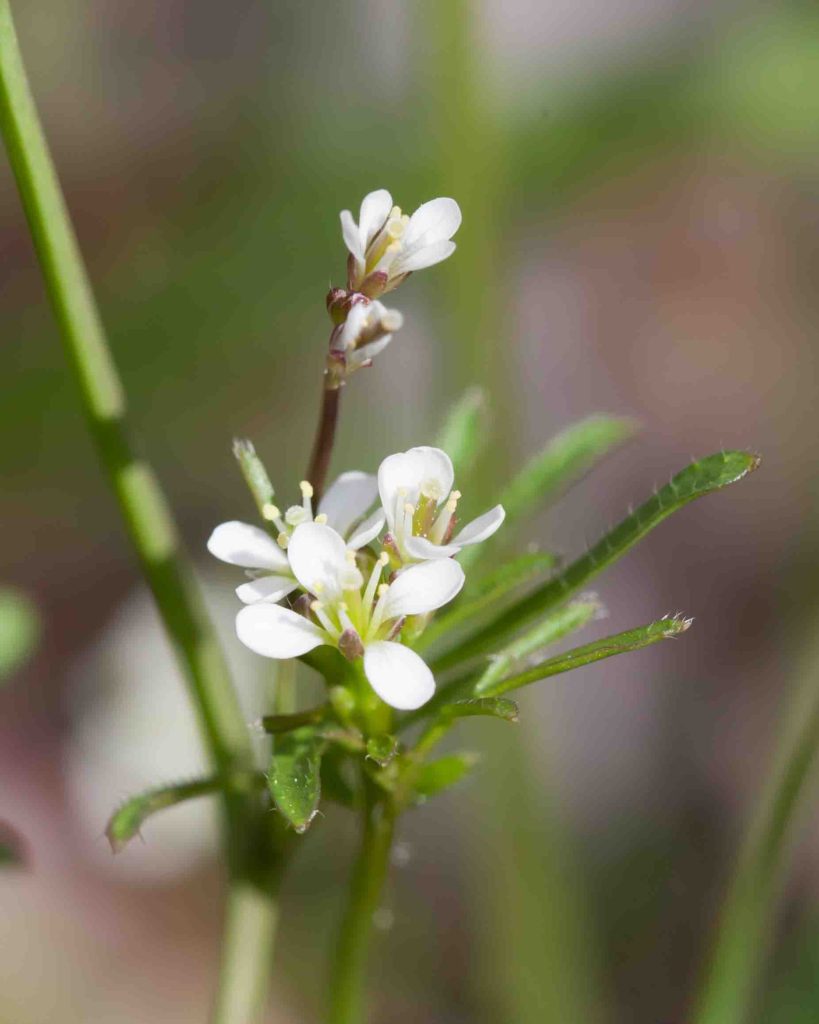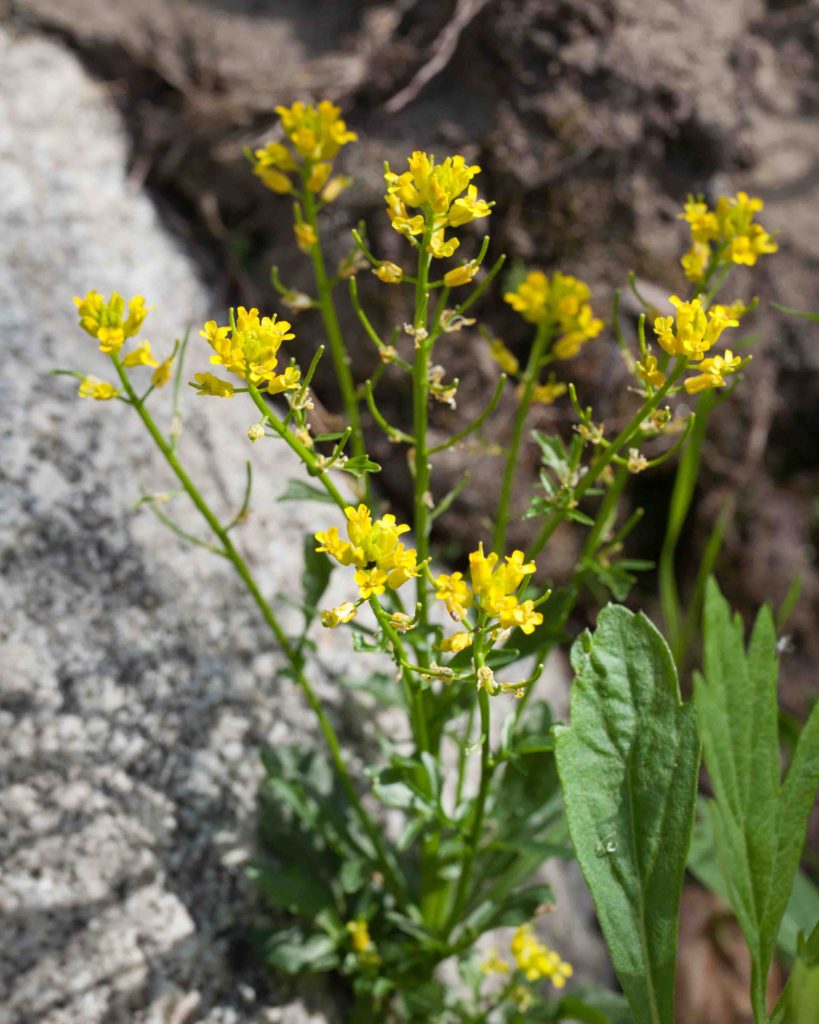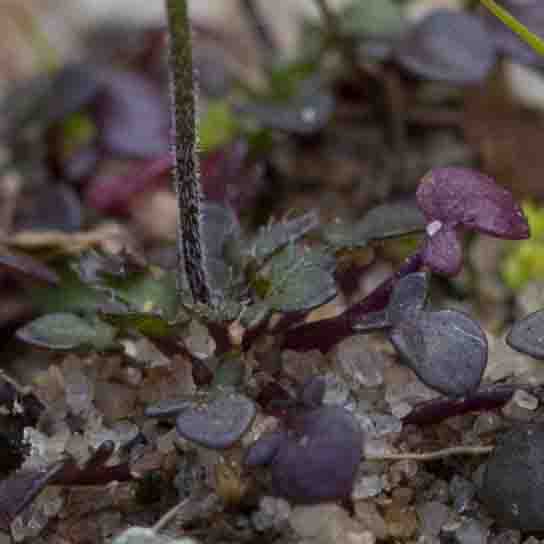Brassicaceae: Mustard Family — Cress
Members of the mustard family all have four petals, usually in a cross shape (hence Cruciferae; the old name for the family). With some groups, the flowers are quite similar, so it helps to pay close attention to the fruits. Fruits in the Mustard family are of two kinds, siliques and silicles. Siliques are at least twice as long as they are wide, while silicles are less elongated. Some siliques are more or less cylindric, others (as in the Wild Radish) are noticeably fatter at the base and taper towards the tip. Some silicles are erect and appressed to the stem, others grow outwards and curve upwards, or outwards and curve downwards.
Mouse-ear / Thale Cress – Arabidopsis thaliana
Blooms:
Feb–May
Plant Height:
6–30 cm
Flower Size:
Very small
Origin:
Eurasia
Habitat:
Disturbed ground, sandy areas, flats, fields
Notes:
An uncommon cress, found on Fort Ord. It has diminutive white flowers with 6 stamens and 4 petals. Fruits are spreading to ascending, cylindric siliques, 1–5 cm long, hairless and unsegmented, borne on distinct pedicels. It has a well-formed basal rosette of hairy leaves.
American Winter Cress – Barbarea orthoceras
Blooms:
Mar–July
Plant Height:
20–60 cm
Flower Size:
Small
Origin:
Native
Habitat:
Moist places, usually above 700 m
Notes:
This is closely related to the mustards, but the glabrous leaves and the pinnately lobed leaves subtending the flower heads are distinctive, as is the vivid green coloring. There is also a basal rosette of leaves, each with 2–4 pairs of lobes.
Milkmaids / California Toothwort – Cardamine californica
Blooms:
Jan–May
Plant Height:
27–70 cm
Flower Size:
Medium
Origin:
Native
Habitat:
Shaded sites, woodland
Notes:
This is one of the most common shade-loving plants blooming in early spring. It has loose clusters of pure white (occasionally pink-tinged) 4-petalled flowers on distinct pedicels. Leaves have 3–5 leaflets of varying shapes, from narrow and arrow-shaped through broad to rounded, sometimes with small but distinct lobes. Photos #2-3 by CJH.
Hairy Bitter-cress – Cardamine hirsuta
Blooms:
Feb–July
Plant Height:
10–35 cm
Flower Size:
Very small
Origin:
European
Habitat:
Shaded sites, woodland
Notes:
This is a common weed with tiny white flowers. The petioles of its leaves have hairy margins. The basal leaves are round to kidney-shaped (see photo #4), with cauline leaves smaller and sometimes narrower. It is similar to Western Bitter-cress (Cardamine oligosperma), but most easily distinguished by a close examination with a hand lens. Western Bitter-cress is not illustrated here, but it lacks the petiole hairs. Also, Hairy has 4 (occasionally 6) stamens, while Western consistently has 6.
Heart-podded Hoary Cress / Whitetop – Lepidium draba
Blooms:
Apr–Aug
Plant Height:
20–65 cm
Flower Size:
Medium cluster
Origin:
Europe
Habitat:
Disturbed areas, pastures, fields
Notes:
The plant has a stout, erect, branched stem. Cauline leaves are 3–9 cm long, ovate to obovate and widely spaced. The inflorescence is slightly domed, with individual flowers on pedicels of varying lengths. Petals are white, clawed and twice the sepal length. Fruits are flat, heart- to kidney-shaped, the top neither winged nor notched. Photo #3 by CJH.
Watercress – Nasturtium officinale
Blooms:
Mar–Nov
Plant Height:
10–110 cm
Flower Size:
Small
Origin:
Europe
Habitat:
Streams, springs, marshes, lake margins
Notes:
This is commonly found in or by streams in sometimes dense mats, with small clusters of white flowers. Stems can be long, but are weak and mostly prostrate, rooting at nodes. Leaves are pinnately parted, with 3–9 round to lanceolate leaflets, which have a peppery taste. Fruits are cylindric siliques, straight or up-curved and narrowed between individual seeds.
Western Yellow Cress – Rorippa curvisiliqua
Blooms:
Mar–Sept
Plant Height:
10–40 cm
Flower Size:
Medium cluster
Origin:
Native
Habitat:
Streambanks, seeps, mud flats
Notes:
Much branched from its base. The basal leaves are not rosetted and are noticeably toothed. Cauline leaves are pinnately lobed. The inflorescence is elongated. The conspicuously upturned siliques are distinctive, giving the species its scientific name.
Shepherd’s Cress – Teesdalia nudicaulis
Blooms:
Feb–May
Plant Height:
5–15 cm
Flower Size:
Very small
Origin:
Europe
Habitat:
Disturbed areas
Notes:
An uncommon cress, to be found on Fort Ord. Like Mouse-ear Cress (Arabidopsis thaliana, see above), it has diminutive white flowers clustered at the stem tips, each with 6 stamens and 4 unequal petals. The fruit is a silicle (quite different from the siliques found on Mouse-ear Cress), heart-shaped to round with a shallow notch at the tip. There are two seeds in each chamber (an important diagnostic feature). Leaves are in a well-formed basal rosette, glabrous and entire or irregularly lobed.





